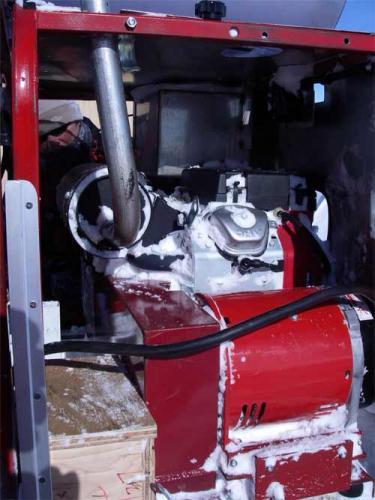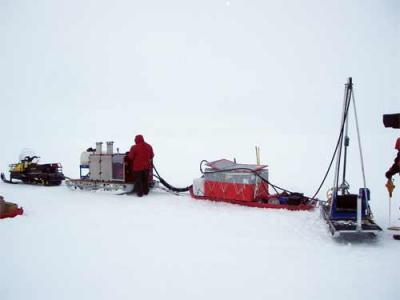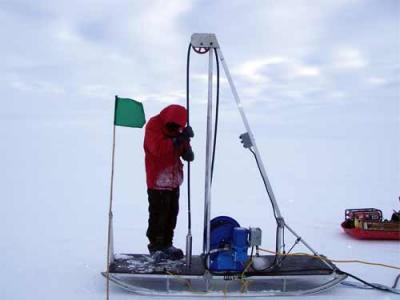Location: The not so stormy WAIS Divide
Yesterday, as suggested by the previous journal, we spent most of the day digging out. It was like a huge avalanche buried all of our gear and we had to find it. Luckily the hardest part wasn’t finding our stuff since we had flagged everything when we got here. The tough part was digging out. This wasn’t a soft snow as you might imagine because all it does when the wind is blowing that hard the snow hits something and just stops, then continues to get more and more packed as the wind keeps blowing. Needless to say, it was quite a job. Our drill has side panels on it and somehow the snow made it through the panels and was compacted into every single crevasse! Not a good situation!
The Snowpacked Drill
 The drill after being partially cleaned out from the storm.*
The drill after being partially cleaned out from the storm.*
This morning, after all the digging out was done; it was time to fire up the drill! That was another long and drawn out process that involved a bullet heater with 60,000 Btu! What snow we didn’t get out the day before had to be melted out of the little engine pieces that we couldn’t get our hands into. This took over 3 hours to get the entire drill warmed up and ‘thawed out!’ Then of course we had to stop for lunch. The problem was that at this point we had to keep things going on the drill or it would freeze up again. So we took lunch in shifts to keep the drill warm and then after lunch, finally fired it up and boy did it sound pretty!
*Hot Water Drilling 101:
*The entire sled consists of four parts, the ski-doo (to pull the other three pieces), the drill sled, the water sled, and the winch sled. The drill sled is where the water is passed through dual burners to heat the water to roughly 45 C. The water sled holds the water, approximately 150 gallons. Side story about the water, this part is quite important. There is no fresh water around here so we have to melt snow. You can’t just throw snow into a bucket and melt it or you will scorch your pot. We have to start with water from the storage tanks here at camp, start the water heaters on the drill sled, and then start shoveling the snow. To drill one hole uses around 100 gallons of water, and the melting snow process repeats itself! It sure helps to keep warm though.
The Rig
 The entire rig, skidoo, drill sled, water sled and winch sled.*
The entire rig, skidoo, drill sled, water sled and winch sled.*
There are hoses passing water through the whole system until finally you get to the winch sled. This is where the hose goes over a pulley and the drill head is lowered through the ice. The hot water comes out of the nozzle at the end of the drill at 600 psi, melting the snow and ice while the steel drill is pulled through the hole by gravity. We let the drill ‘fall’ to roughly 30 meters and then we start to retraction process. Measurements are taken to find the exact depth and then the explosive charges are wired and dropped into the holes.
Drilling!
 Brandon drilling a 30m deep hole.*
Brandon drilling a 30m deep hole.*
We drilled and armed a total of seven holes today. Tomorrow, BLAST DAY, weather permitting. It looks like there may be another storm headed this way tomorrow afternoon or evening. :( I guess that’ just life down here. Remember, it’s a harsh continent!

